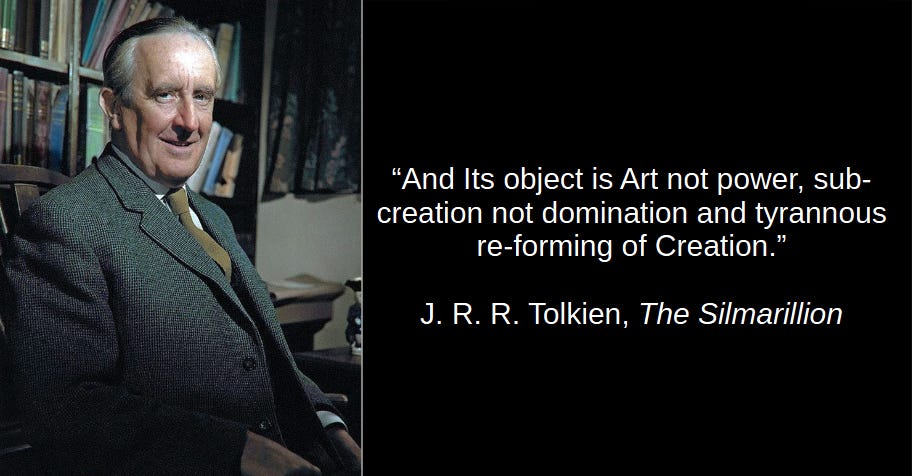“You Shall Be Like God”: Technology from Sub-creation to Displacing the Creator
Part 2 – The Concept of Sub-creation
Part 1 of this paper can be found here.
What is the right place for humanity in this world? We are called to be stewards, and this includes developing tools. A helpful concept comes from J.R.R. Tolkien who describes our work as sub-creation. He argues since we were created in the image of God, we can create things, in his case fictional worlds, not as our own independent creations but as creations under the Creator.
Technology, at its most basic level, is defined by Merriam-Webster as “the practical application of knowledge.”[1] In other words, a technology is taking something we have learned about the world and creating a practical application with it. As God created us in His Image, He has given us the ability to learn about the world He created, and His command to exercise dominion and care for the creation means that we should develop technologies to use for that good. A simple example of this would be the hoe which we use to remove weeds and cultivate vegetable plants. Of course, more complex technologies can also be used in this way.
We also know that technologies can be used in service to God, particularly to help spread the Gospel. For instance, Luther used the technology of the printing press to spread the Gospel. Up until this time, the printing press was used to provide texts for the wealthy and students in a manner that was cheaper than paying for a manuscript. Then Luther used the technology to create short, cheap to make and purchase, pamphlets that helped spread the Gospel throughout Europe faster than the papacy could stamp it out.[2] In a similar way, the technologies of radio,[3] television, and the internet have been used to spread the Gospel.
Likewise, we very often use technology to help our neighbor. Most technological advances fit into this category. From advanced farming to medicine to the automobile, these forms of technology were developed to help others in their earthly lives.
Perverting Technologies to Sinful Ends
On the other hand, technology can be used in direct opposition to God. The Tower of Babel illustrates how we tend to use technology not for God or even for healthy care of creation but to displace the creator. The technology that was used – building – can be used in a variety of God-pleasing ways including to provide housing and to create churches. The problem with Babel came in that the technology was used in direct opposition to God’s command with the goals to “make a name for ourselves, lest we be dispersed over the face of the whole earth” (Gen 11:4). Here the goals were to glorify themselves rather than God and to defy God’s command to “fill the earth” (Gen 9:1).
The problem is that we, since the Fall, have perverted technologies. It doesn’t matter what the technology is, sinful human beings will use it for sinful purposes. For instance, while the internet was designed for the sharing of research and military coordination, it is well documented that pornography has become the largest industry on the internet.
It is easy to idealize things and think that the corruption of technologies is a more modern thing. Nonetheless, this is not new; however, what is new is the pace at which new technologies are being developed. Contrary to popular belief, however, this is not because we are smarter; rather it is caused by a couple of factors. First, science and technology always build on earlier discoveries, which tends to accelerate things. Second, there are more people in the world – 8.1 billion people in the world today versus an estimated half a billion people in the 1500s. That means that the percentage of inventive people would have to have been multiplied by over 16 times to be the same number of people, and when you add the development of nearly universal education, more of those people today are capable of inventing things that could be used beyond their peasant farm! Third, the increase of communications helps to minimize the replication of inventions and helps inventors build on each other’s work.
We have, however, also seen a dramatic shift to where we are now thinking that we can truly replace the Creator. In this, the world is now trying to become like God. While it is easy to say that this is the way of human sin, there have been some historical shifts that have pushed us in this direction.
The next post will explore a few of the more pertinent of these shifts.
[1] “Definition of TECHNOLOGY,” Merriam Webster, 16 June 2024, https://www.merriam-webster.com/dictionary/technology.
[2] Andrew Pettegree, Brand Luther: How an Unheralded Monk Turned His Small Town into a Center of Publishing, Made Himself the Most Famous Man in Europe--and Started the Protestant Reformation (New York: Penguin, 2016).
[3] Walter A. Maier was particularly influential with the development of The Lutheran Hour as a means of radio evangelism.




